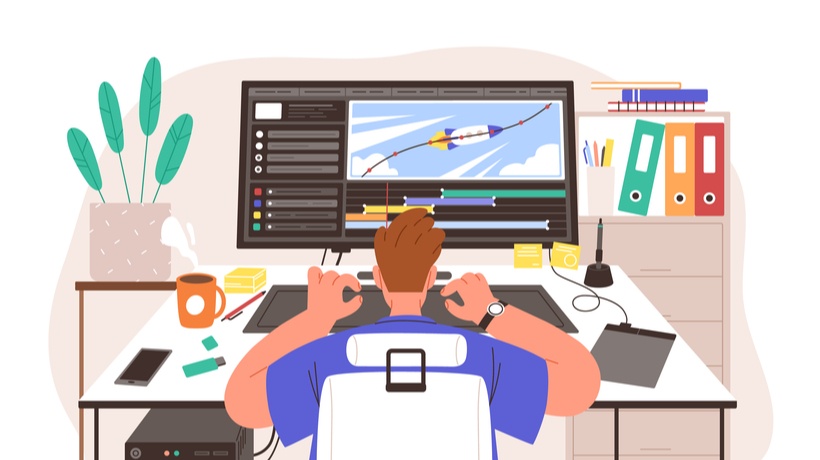From the 1600s until the present, animation has been bringing visions to life, from the beloved animated pictures of our youth to the state-of-the-art computer graphics found in blockbusters.
Animation has only grown in popularity in our culture with the invention of contemporary animation technologies like Flash and Creation, progressing from simple flip books and cartoons to online applications and promotional materials. Animations have transformed, or even inspired, entire businesses, such as data visualization. They can instruct, amuse, and present facts in a way that is understandable to the spectator. This blog will dive deeper into the key animation concepts

2D animation: What is it?
You should educate yourself on the definition of 2D animation before diving fully into the field. It was evident to us as kids watching our favorite Saturday morning cartoons that animation was something more than merely a series of pictures played in order, but just how much more precisely? At its most basic, animation is just a sequence of images, or frames, that are rapidly rolled along a timeline or reel. What then makes animation effective?
Animated content produced in a two-dimensional setting as opposed to a three-dimensional one is known as two-dimensional animation. The characters and settings for many contemporary animation films (like DreamWorks and Pixar) are made using 3D animation technologies, which shape the characters from hundreds of small digital polygons and animate them with computer code like puppets on strings. Instead of using complex digital models or virtual environments, 2D animation takes a simpler approach, just creating the frames of each scene and leaving the rest up to our imagination.
To make the animated features we see on TV and in movies, of course, modern 2D animators need more than just paper and pencils. Contemporary films are expected to have astonishing detail and artistic integrity, and 2D animation has completely embraced digital technology to achieve this. While some digital programs designed for 2D animators are quite specialized and only capable of carrying out a single task, others include nearly everything required to create a full-length animation on your home computer.
The Power of 2D Animated Storytelling
2D animation is a very effective tool for storytelling. It can seamlessly convey emotions and narratives through its quality visual language. 2D animation uses vibrant colors, expressive characters, and dynamic movements to bring stories to life in a way that resonates deeply with viewers. The simplicity of the visuals of 2D allows for clear and direct communication of feelings and messages. From message simplification by whiteboard animation services in 2d format to a dramatic moment, the art of 2D animation captures the essence of the story which makes it accessible and engaging for all audiences. The timeless charm and creativity that it has makes it a demanding medium for storytelling.
The Enchantment of 2D Animation: Creating Timeless Characters, Visual Stories, and Dynamic Movements
Character Design
The design of characters is crucial in 2D animation because it helps establish who the characters are, what they feel, and their roles in the story. If a character is well-designed, it can quickly convey emotions and personality traits which makes them relatable and memorable to the audience.
To build memorable characters, there are the following elements to keep in mind. To give a shape to your character you can give them unique silhouettes that can be easily recognized even in shadow. A different color palette helps these characters stand out and can reflect their personality. Moreover, it can also show character emotions through facial expressions making it easier for viewers to connect with them.
Visual Storytelling:
Visual storytelling uses composition, framing, and background in 2D animation to convey information and emotions. It makes it easier for animators to show rather than tell which makes the experience of the audience more engaging.
There are some techniques like camera angles, lighting, and color theory that play a significant role in visual storytelling. For instance, a high camera angle can make a character look in danger, whereas warm lighting can give a cozy atmosphere. By understanding the color theory, animators can use colors that evoke specific emotions and highlight important elements in a scene.
Animation Principles:
There are some fundamental principles of animations like squash stretch and anticipation, which are essential for creating real movement. The principles make the character’s actions feel more natural and believable while enhancing the overall storytelling.
These features give characters flexibility and weight, which makes the movements more complex. Anticipation excites the audience for what is coming next, making the action smoother and more understandable.
Tips and Actionable Steps to Empower Aspiring Animators
If you are an eager animator, start by drawing skills and look over the work of master animators. Put your focus on making characters that are simple and then swiftly add more details into it. Play with different shapes, colors, and expressions for better exposure. You can also make use of online tutorials and animation software to practice the fundamental principles of animation, squash, and stretch.
Additionally, to appreciate the difference between 2D animation you can watch classic and modern animated films. One should pay attention to character designs, backgrounds, and movements. Analyzing how emotions and stories are conveyed visually is equally important. Embrace 2D video animation services to discover the endless possibilities of this everlasting form of art.
Conclusion:
2D animation is a useful and appealing art form that brings stories to life. By focusing on character design, visual storytelling, and animation principles every newbie animator can create engaging and memorable experiences. By practicing drawing, reviewing good work, and learning key animation techniques, aspiring animators can make a great difference. From creating to watching, the magic of 2D animation lies in its ability to link with the audience and convey emotions through its unique visual language.
